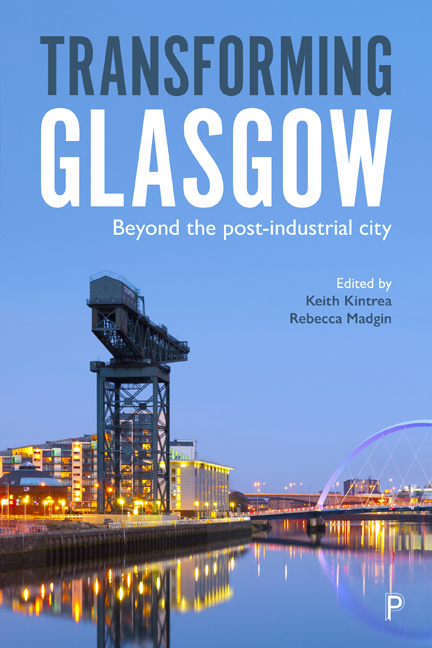Book contents
- Frontmatter
- Contents
- List of Maps, Tables, Figures and Boxes
- Notes on Contributors
- Acknowledgements
- Foreword
- Map
- Introduction: Transforming Post-Industrial Glasgow – Moving Beyond the Epic and the Toxic
- PART I
- PART II
- PART III
- Conclusion: Beyond the Post-Industrial – Narratives of Time and Place
- Index
8 - ‘New’ Migrations Transforming the City: East European Settlement in Glasgow
Published online by Cambridge University Press: 25 March 2021
- Frontmatter
- Contents
- List of Maps, Tables, Figures and Boxes
- Notes on Contributors
- Acknowledgements
- Foreword
- Map
- Introduction: Transforming Post-Industrial Glasgow – Moving Beyond the Epic and the Toxic
- PART I
- PART II
- PART III
- Conclusion: Beyond the Post-Industrial – Narratives of Time and Place
- Index
Summary
Contemporary migrations are literally re-making cities (…) and this is not a banal fact of changing population demographics
Nicholas de Genova (2015, p 4)Introduction
We are living in an ‘age of migration’ (Castles, de Haas and Miller, 2013) within which ‘migration and the city can be viewed as two sides of the same coin, having built and accompanied each other's development over the centuries leading to the contemporary global system’ (Portes, 2000, p 154). Over the last 50 years, economic and technological developments in the global North have led to the rise of ‘global cities’ and created particular demands for migrant labour (Wills et al, 2010). International migration, whilst by no means a new phenomenon, has taken on new features and brought new changes to cities like Glasgow as they become differently embedded in the economic, political and social configurations of the contemporary world.
In the global North, the neo-liberal reforms of the 1980s produced a new model of employment. Many industries moved to subcontracting and other flexible employment arrangements. As a result, lowskilled and low-paid jobs no longer came with the benefits of stable employment or strongly unionised workforces able to demand labour rights (Standing, 2011). Such jobs became less attractive to the local population. At the same time, the service sector expanded considerably, especially in ‘global cities’ (Sassen, 2001), creating a growing need for cheap and flexible labour. These developments created new opportunities as well as new forms of precarity for migrant workers.
Other political and economic processes in sending countries have also impacted on the scale and nature of international migration flows. Compared with the mass migrations that followed the Second World War, migration trends from the 1980s onwards have been characterised by increasing diversification of countries of origin, length of stay, categories of migrants and their motivations (Pardo, 2018, p 3). In Europe, this led to the expansion of multicultural urban societies (Castles and Davidson, 2000; Castles, de Haas and Miller, 2013; Koser and Lutz, 1998; Thranhardt, 1996), some of which have become ‘super-diverse’ (Vertovec, 2006).
On the European continent, shifting migration flows and trajectories over the last three decades have also been shaped by geopolitical changes which began with the fall of East European communist regimes in the late 1980s, the end of the Cold War and relaxation of border controls between East and West Europe.
- Type
- Chapter
- Information
- Transforming GlasgowBeyond the Post-Industrial City, pp. 159 - 178Publisher: Bristol University PressPrint publication year: 2019

